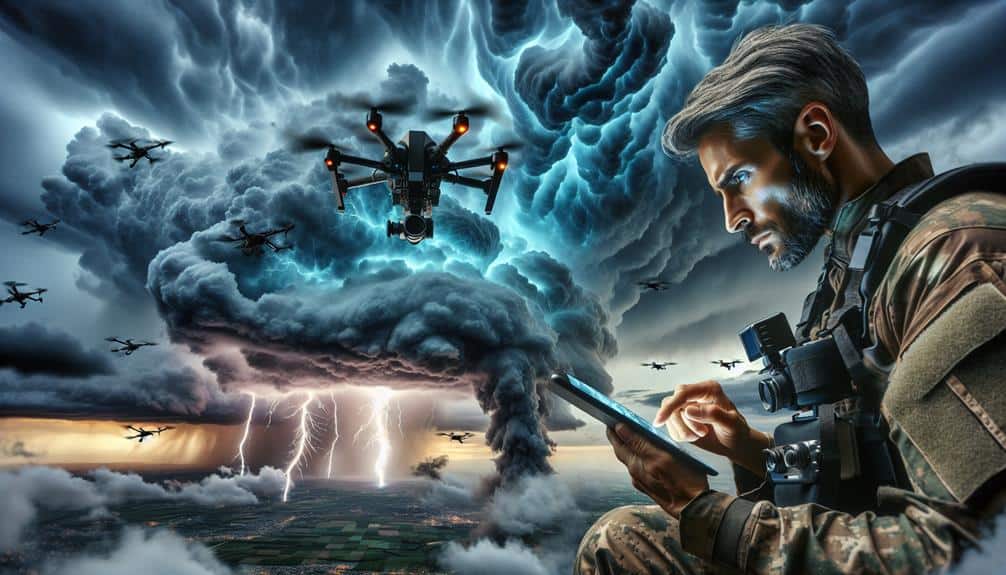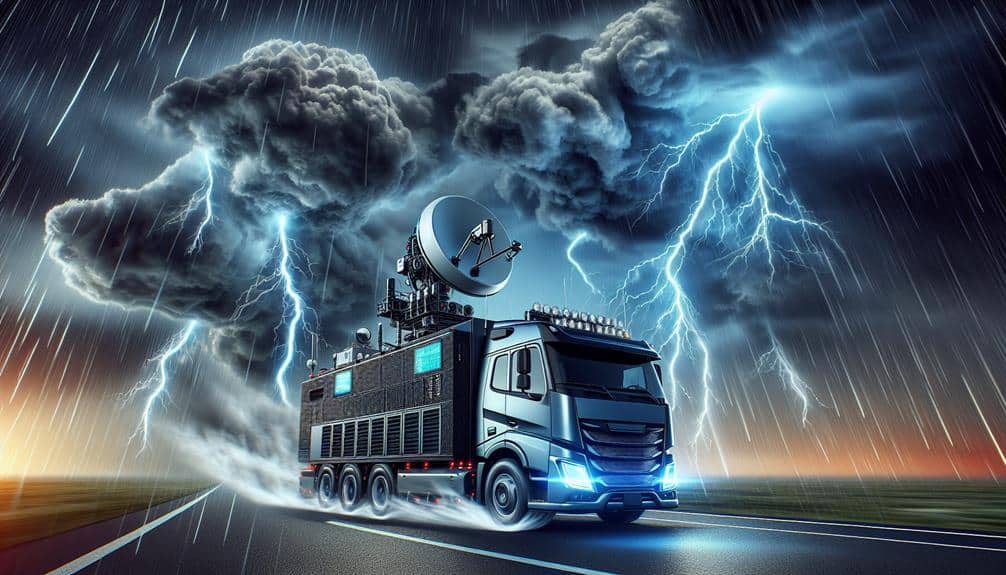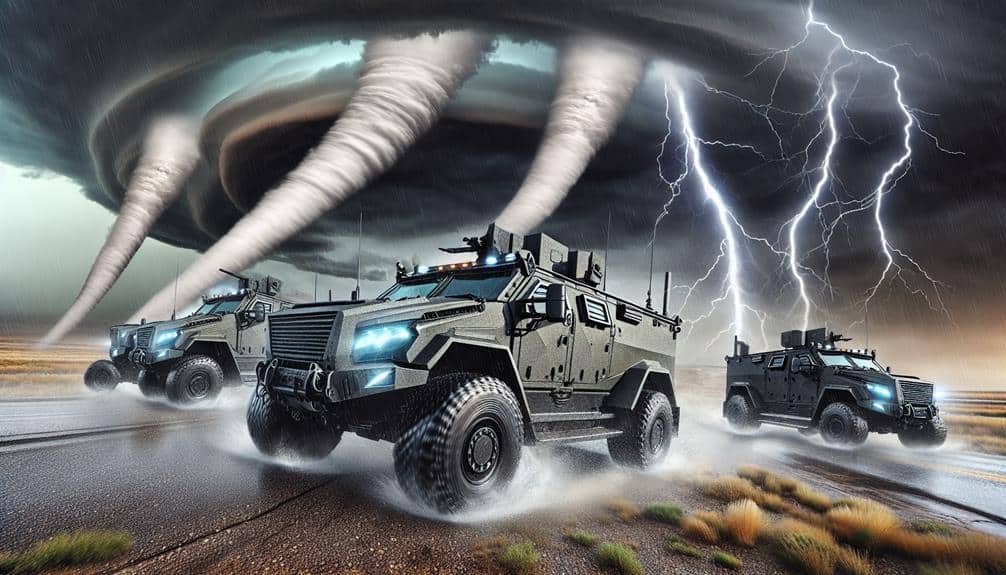When we're out chasing storms, reliable communication is key. Satellite phones are indispensable for their global coverage, ensuring we stay connected in remote areas. Two-way radios provide instant communication with our team, vital during high-stress moments. Mobile weather stations give us real-time data on atmospheric conditions, while GPS devices keep us accurately on track. Drones equipped with high-resolution cameras capture essential footage, even handling turbulent weather. Finally, emergency beacons are our lifeline, enabling distress signals and real-time location tracking. Understanding these tools helps us make informed decisions and enhances our safety during storm-chasing adventures. Stay with us to explore each device in detail.
Key Points
- Satellite phones provide global coverage and reliable communication in remote areas.
- Two-way radios ensure instant communication with team members over several miles.
- Mobile weather stations gather real-time data with durable, portable designs.
- GPS devices offer pinpoint location tracking and maintain connectivity in remote regions.
Satellite Phones
When it comes to ensuring dependable communication in remote areas, satellite phones are indispensable for professional storm chasers. We understand that when we're deep in the heart of a tempest, standard cell networks often fail us. That's where satellite phones shine. They provide unmatched signal coverage, allowing us to maintain contact no matter how far off the beaten path we venture.
Imagine being in a remote location, cut off from the world, with the storm raging around us. Satellite phones guarantee our communication reliability, keeping us connected to our teams and emergency services. This isn't just about convenience; it's about safety. In life-threatening situations, having a reliable means of emergency communication can make all the difference.
Satellite phones operate through a network of satellites orbiting the Earth, far above the disruptions caused by severe weather. This global coverage means we can transmit essential information and receive updates regardless of the conditions on the ground.
For us, being able to communicate effectively in the most extreme environments gives us the freedom to chase storms confidently, understanding we're never truly alone, even in the most isolated locations.
Two-Way Radios
Two-way radios are an important tool for professional storm chasers, ensuring we can communicate instantly with our team members even when cellular networks are down. These devices offer reliable communication, which is vital when we're tracking volatile weather patterns and need real-time updates.
The signal range of two-way radios is a key factor, as it determines how far we can be from each other while still maintaining clear communication. High-quality models can cover several miles, making them perfect for the expansive areas we often traverse.
Battery life is another crucial aspect to take into account. A long-lasting battery ensures that our radios won't die during important moments. Many high-end two-way radios come with extended battery life, often lasting up to 24 hours or more on a single charge. This feature is invaluable during extended chases when access to power sources might be limited.
Moreover, two-way radios are built to withstand harsh conditions, including heavy rain and strong winds, which we frequently encounter. Their rugged design and dependable performance make them indispensable in our kit. Essentially, these devices offer the freedom to explore and chase storms without worrying about losing contact with our team.
Mobile Weather Stations
When we use mobile weather stations, we're equipped with the tools to collect real-time data essential for tracking storms. These devices are designed to be both portable and durable, ensuring they withstand harsh conditions while providing accurate measurements.
Let's explore how these features benefit us in the field and enhance our storm-chasing capabilities.
Real-time Data Collection
In the field of storm chasing, mobile weather stations are essential for gathering real-time data crucial to predicting and understanding severe weather phenomena. As storm chasers, we depend on these advanced devices to monitor conditions on the go. They allow us to collect important data such as wind speed, atmospheric pressure, and humidity levels, which are then analyzed to forecast the storm's path and intensity.
Our ability to perform accurate data analysis depends on the quality and immediacy of the information we receive. Mobile weather stations are equipped with multiple sensors that provide real-time data into our systems. This continuous flow of information allows us to make prompt, informed decisions while in the field.
Furthermore, a strong communication network is critical for sharing our findings with meteorological centers and fellow storm chasers. The integration of mobile weather stations with advanced communication networks ensures that data is transmitted efficiently and reliably, even in the most remote locations. This seamless connectivity enhances our collaborative efforts, making us more effective in predicting and responding to severe weather events.
Portable and Durable Design
Our mobile weather stations' sturdy and small-scale designs guarantee they withstand the harshest conditions while remaining easy to transport. As professional storm chasers, we understand the significance of having reliable equipment that won't let's down when we're in the field. That's why our mobile weather stations are built with a focus on durability and portability.
The key features that make our weather stations stand out include:
- Waterproof technology: Assures our devices stay operational even in torrential rain.
- Shock resistant casing: Shields sensitive components from drops and impacts.
Our weather stations' compact size means we can easily carry them wherever we go, without feeling weighed down. The waterproof technology guarantees that even in the most severe weather, our data collection remains uninterrupted. The shock resistant casing adds a layer of protection, safeguarding our investment against the inevitable bumps and drops that occur during high-energy chases.
With long lasting battery life, we don't need to worry about our equipment failing us at a critical moment. These features collectively provide us with the freedom to chase storms with confidence, understanding our gear will perform when we need it most.
GPS Devices
Storm chasers depend heavily on GPS devices to track severe weather patterns and navigate challenging terrains with pinpoint accuracy. When we're out in the field, the last thing we want is a device that loses signal or dies quickly. A GPS device's signal strength and battery life are critical factors.
Superior signal strength guarantees that we can maintain connectivity even in remote, storm-prone areas where cell service might be unreliable. Long battery life is equally vital, as it allows us to stay operational for extended periods without the constant worry of recharging.
The accuracy and reliability of a GPS device can make or break our storm-chasing missions. High accuracy means we can pinpoint our location to within a few meters, giving us the confidence to make split-second decisions that could save lives. Reliability ensures that our equipment won't fail us when we need it most.
Devices like the Garmin GPSMAP 66i and the DeLorme inReach Explorer+ offer robust performance, combining excellent accuracy with durable designs.
Ultimately, our choice of GPS device reflects our need for freedom—freedom to pursue storms wherever they lead, knowing we're equipped with technology we can trust.
Drones With Cameras

Let's explore how drones with high-resolution cameras, real-time video streaming, and enhanced durability features revolutionize our storm chasing efforts.
These advanced drones help us capture detailed footage, stream live data, and withstand harsh weather conditions.
High-Resolution Camera Quality
Drones equipped with high-resolution cameras have revolutionized the way we capture and analyze storm data from the skies. These flying marvels give us the freedom to explore and document severe weather phenomena like never before. To fully appreciate the capabilities of these drones, let's delve into some key aspects that make them essential for professional storm chasers.
- Camera lens quality, image stabilization: High-grade lenses ensure we're capturing every detail, even in the most turbulent conditions. Coupled with advanced image stabilization, our footage remains clear and steady, eliminating the blurriness caused by drone movement.
- Low light performance: Storms often bring dark, foreboding clouds, making low light performance vital. The latest drones excel in these conditions, allowing us to capture sharp, detailed images even when the skies are at their darkest.
Real-Time Video Streaming
By utilizing live video streaming, we can offer immediate and crucial updates on storm developments, guaranteeing timely and precise information distribution. This ability is particularly impactful when utilizing drones equipped with high-quality cameras. These devices allow us to capture and broadcast real-time footage of severe weather events from vantage points that were previously inaccessible.
The incorporation of drones into our weather tracking arsenal greatly improves our ability to monitor storm progress in real-time. As professional storm chasers, we recognize the significance of being at the forefront of technological advancements. Live video streaming not only keeps our audience informed with live updates but also guarantees that emergency services receive the most accurate and current data possible.
These drones give us the freedom to explore dangerous environments without putting ourselves in immediate danger. The high mobility and accessibility of drone technology enable us to track the storm's path, intensity, and development with unparalleled precision.
Enhanced Durability Features
When pursuing storms, we depend on drones with enhanced resilience features to withstand harsh weather conditions and guarantee uninterrupted data collection. These drones are our eyes in the sky, capturing vital footage and data in real-time, regardless of the elements.
Let's delve into what makes these drones essential.
First, water-resistant technology is essential. Our drones are equipped to handle heavy rains and high humidity without compromising their functionality. This ensures continuous operation even when the weather becomes unpredictable.
Second, the use of durable materials is vital. Storm-chasing environments are harsh, with strong winds and airborne debris. Drones built with these materials can withstand the physical stress and still perform at their best.
Third, a resilient casing and long-lasting battery are non-negotiable. The resilient casing protects the drone's internal components from sudden impacts and vibrations, which are common during storms. Meanwhile, a long-lasting battery ensures that we can capture extended footage without the concern of running out of power at a crucial moment.
Emergency Beacons
For storm chasers, having dependable emergency beacons can mean the difference between life and death, providing an essential lifeline when other communication devices fail. When we're out in the field, battling the elements, the signal strength and battery life of our emergency beacons are crucial. We need a beacon that can penetrate through the toughest weather conditions and keep us connected for extended periods.
A strong battery life ensures that even if we're stranded, our lifeline remains active, giving us peace of mind.
Another critical feature is SOS functionality. With just the push of a button, we can send out a distress signal to rescue teams, a feature that's invaluable during life-threatening situations. Equally important are the tracking capabilities of these devices. Real-time tracking allows our location to be continuously monitored, making it easier for rescue teams to find us quickly.
In essence, emergency beacons aren't just gadgets; they're our safety net. They grant us the freedom to chase storms with the knowledge that, should the worst happen, we've a dependable way to call for help. Investing in high-quality emergency beacons is non-negotiable for every professional storm chaser.
Frequently Asked Questions
How Do I Maintain the Battery Life of My Communication Devices During Long Chases?
We can preserve battery life by focusing on battery conservation techniques. Using solar chargers and power banks guarantees we're prepared for emergency situations. Let's optimize device settings to prolong usage and stay connected during long chases.
Are There Any Legal Restrictions on Using Certain Communication Devices While Storm Chasing?
We must consider legal restrictions to guarantee safety and avoid signal interference. Some devices might require special licenses or insurance. Let's research local regulations and stay compliant while maintaining our freedom to chase storms.
What Are the Best Practices for Securing Communication Devices in Extreme Weather Conditions?
Did you know that 85% of devices fail in extreme weather? To safeguard our communication devices, we use waterproof cases and signal boosters. These tools guarantee we stay connected and safe, even when nature's at its wildest.
Can Communication Devices Interfere With Each Other's Signals During a Storm Chase?
Yes, signal interference can occur, impacting our safety. We should follow strict communication protocols and strategies to minimize issues. Using different frequencies and reliable devices guarantees clear, uninterrupted communication during our storm chases.
What Insurance Options Are Available for Protecting Communication Devices Used in Storm Chasing?
Imagine our devices engulfed in swirling winds and rain. Device insurance offers coverage against such chaos. Warranty options provide added protection, ensuring we stay connected. Let's explore these options to keep our gear safe and functional.

